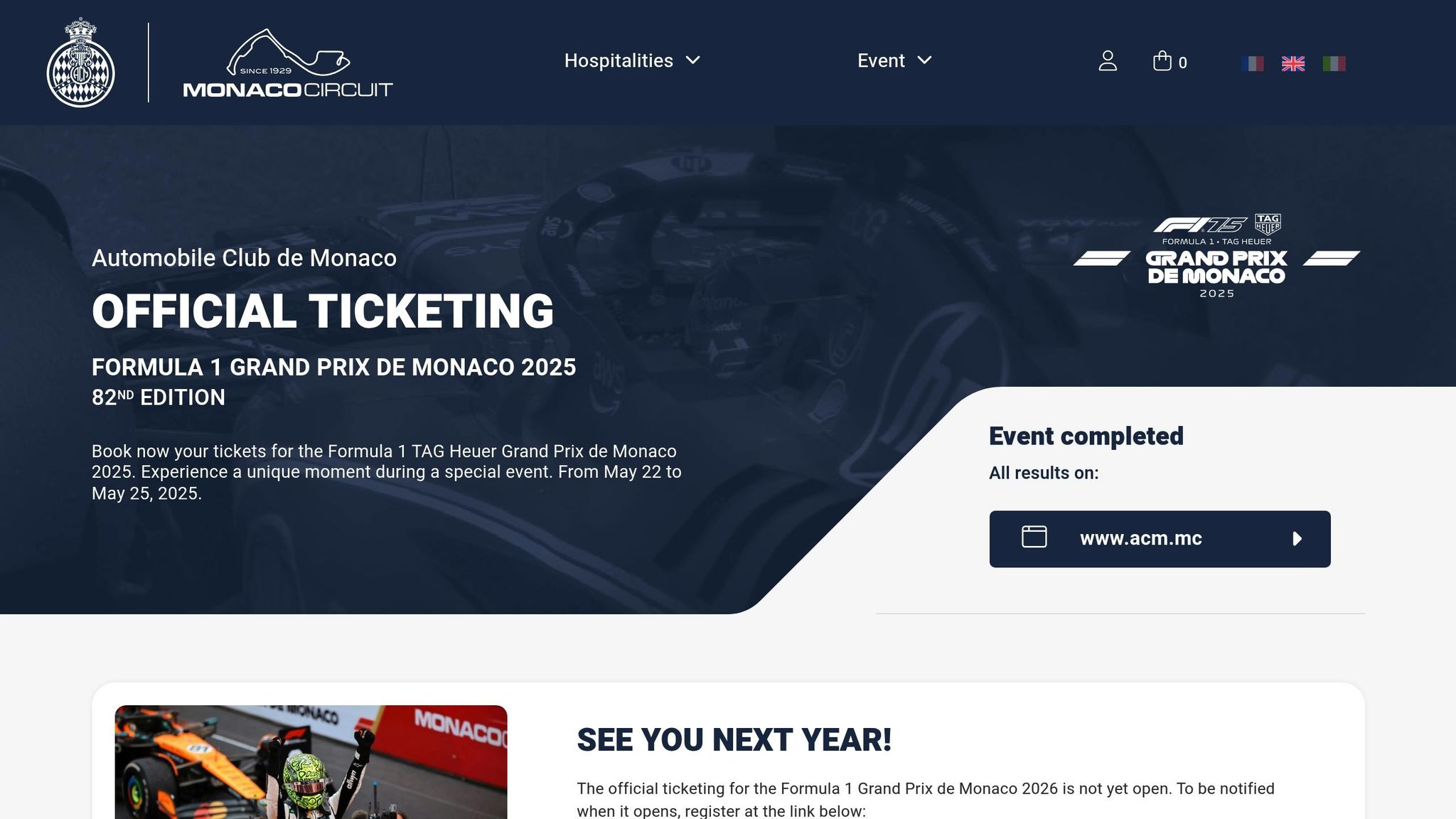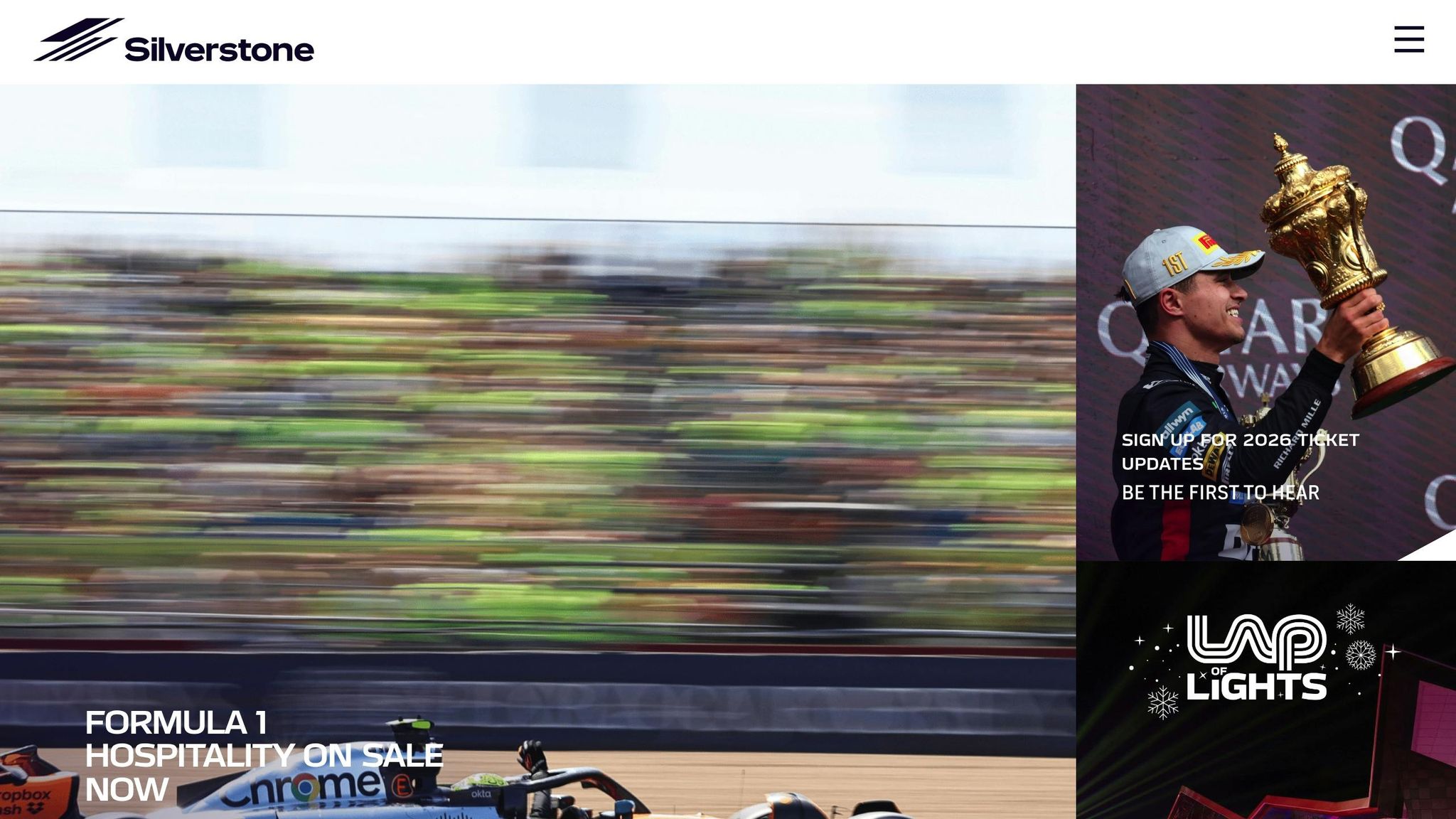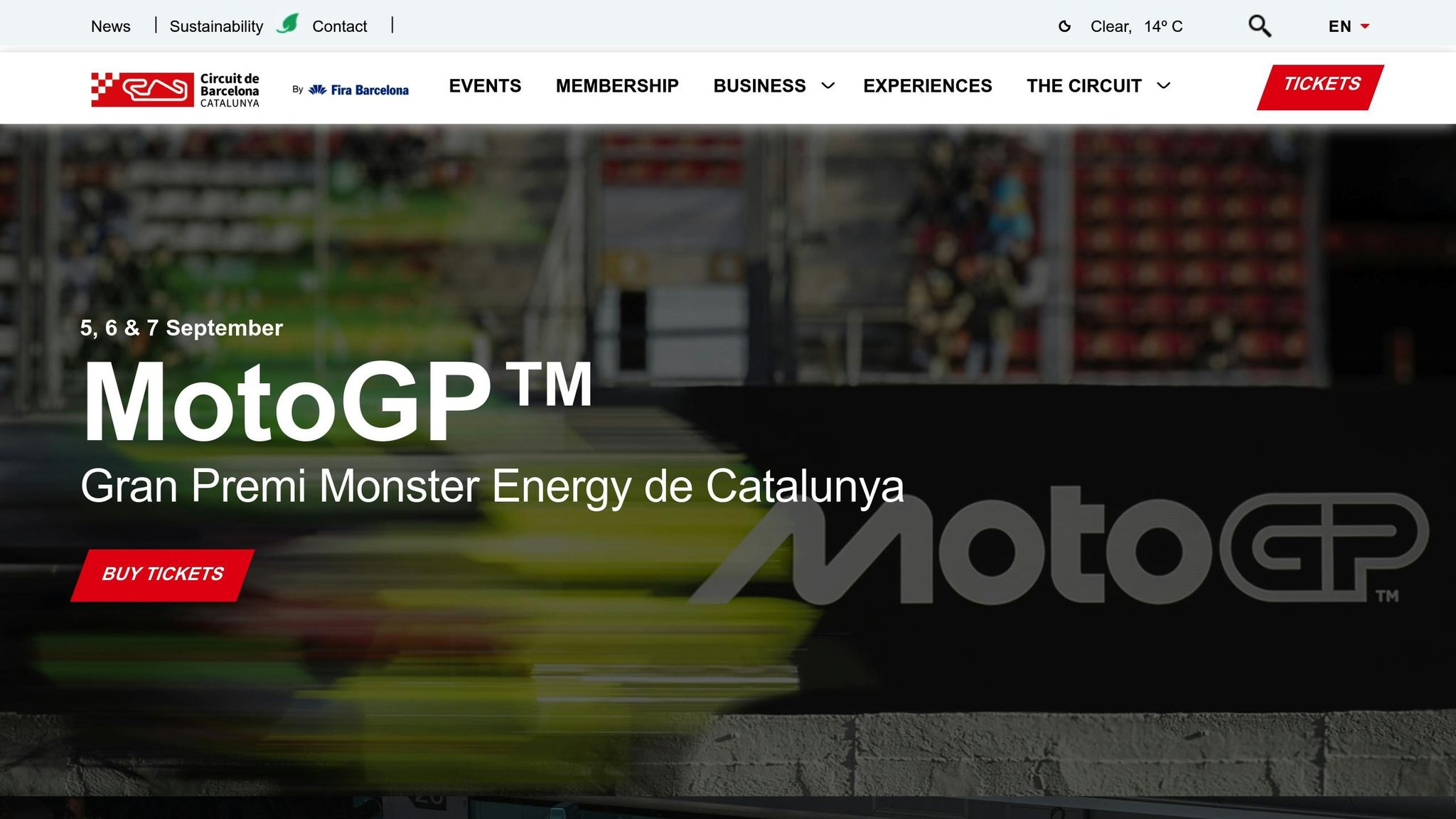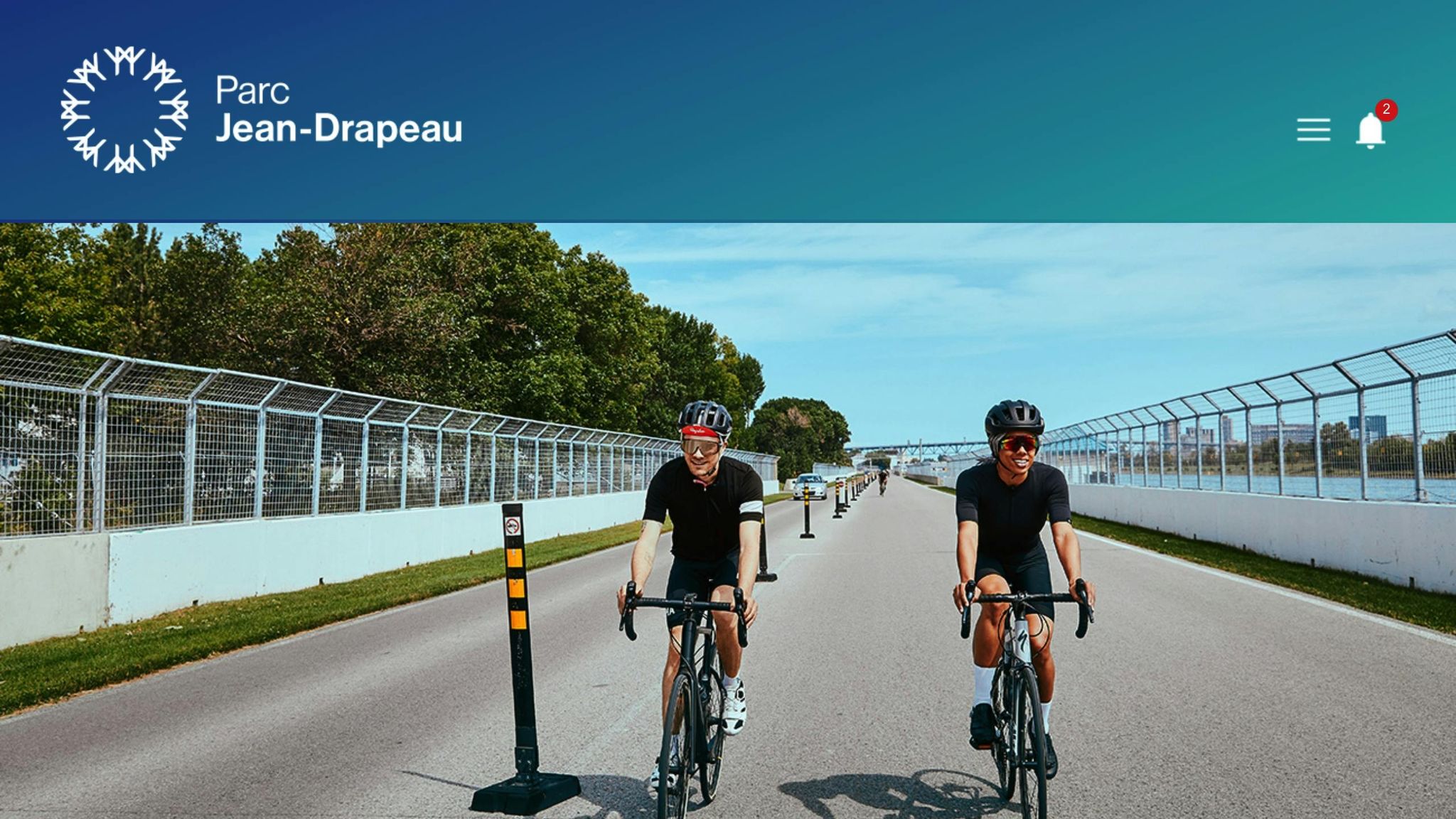Ultimate Guide to F1 Tracks: From Monaco to Silverstone and Beyond
Explore the unique challenges and strategies of iconic F1 tracks, from the tight streets of Monaco to the high-speed corners of Silverstone.

Formula 1 tracks are not just racing circuits - they’re arenas that test driver skill, car engineering, and team strategy. From the tight streets of Monaco to the high-speed corners of Silverstone, each track presents unique challenges. Teams must fine-tune setups to account for surface conditions, weather, and circuit design, all while collecting millions of data points to optimize performance.
Key takeaways:
- Monaco: Known for its narrow streets and minimal overtaking opportunities, precision and qualifying position are critical.
- Silverstone: A fast, flowing circuit that prioritizes aerodynamic balance and tire management.
- Other Circuits: Tracks like Spa, Suzuka, and Barcelona demand varying strategies due to their unique layouts, weather, and elevation changes.
Every circuit shapes race outcomes, making F1 a dynamic blend of engineering, strategy, and driver skill.
Sending It Around Silverstone 💪 | Silverstone Track Guide + Setup
Monaco Grand Prix Circuit: F1's Most Prestigious Race

The Monaco Grand Prix stands as the crown jewel of Formula 1. Since its addition to the World Championship in 1950, this iconic street circuit has been the stage for some of the sport's most unforgettable moments. Its allure isn't just about the race - it's also about the strategic and technical hurdles it throws at teams.
Monaco is part of the prestigious Triple Crown of Motorsport, alongside the Indianapolis 500 and the 24 Hours of Le Mans. The Fédération Internationale de l'Automobile (FIA) calls it "an exceptional location of glamour and prestige". Winning here isn't just about the points - it’s a badge of honor.
Monaco's Track Layout and Features
The circuit, just 2.07 miles long, snakes through the tight streets of Monte Carlo, demanding impeccable precision from drivers. With modern F1 cars being roughly 1.6 feet wider and 3.3 feet longer than those of the 1950s, navigating this compact track has become even more challenging. There's almost no margin for error, making every lap a test of skill and focus.
Racing Challenges at Monaco
At Monaco, qualifying is everything. Since 2004, more than 70% of the races have been won by the driver starting from pole position. To put the difficulty of overtaking into perspective, there were 29 overtakes during the 1993 Monaco Grand Prix. Compare that to today, where passing opportunities are so scarce that strategy and precision take center stage.
Pierre Gasly highlights the razor-sharp focus required:
"It's a lot about precision. It's all about being very precise with your lines, being millimeters away from the rails everywhere, really nailing the braking points. This sort of risk that brings more adrenaline to it".
Valtteri Bottas echoes this sentiment, emphasizing the mental toll:
"Focus is the key. If you can keep the concentration for each corner, each lap, you won't make a mistake".
Given how unforgiving the circuit is, teams must fine-tune car setups for maximum grip and handling while also perfecting pit stop strategies. Every decision matters when the smallest misstep can ruin a race.
Monaco's Place in F1 History
The Monaco Grand Prix has cemented its place in F1 lore thanks to its unique demands. First held in 1929, it has been a yearly tradition, interrupted only by wartime and a handful of other rare events. Legendary drivers like Ayrton Senna and Graham Hill, with six and five wins respectively, have defined its legacy.
In a more recent chapter of Monaco's history, Charles Leclerc became only the second Monégasque driver to win his home race, following Louis Chiron's 1931 victory. That 93-year gap underscores just how rare and difficult such a feat is.
Nelson Piquet once compared racing at Monaco to "riding a bicycle around your living room". He also famously remarked, "a win here was worth two anywhere else", perfectly capturing the prestige associated with triumphing at this iconic venue.
Unlike other races, Monaco's 260-kilometer (161-mile) distance is shorter than the FIA's standard 305-kilometer minimum. But what it lacks in length, it more than makes up for in emotional and historical significance. A win here not only boosts a driver's confidence but also shines a global spotlight on their achievement, solidifying Monaco's place as Formula 1's most celebrated race.
Silverstone Circuit: Britain's High-Speed Challenge

While Monaco is all about precision and tight corners, Silverstone offers a completely different test for Formula 1 drivers and teams. Known as one of the fastest circuits on the calendar, this iconic British track prioritizes aerodynamic efficiency and raw speed over the intricate maneuvering required in Monte Carlo.
Spanning 3.66 miles (5.891 kilometers) with 18 turns, Silverstone allows drivers to maintain high momentum through its sweeping corners. Unlike the stop-and-go nature of street circuits, this track challenges teams to find the perfect aerodynamic balance to maximize speed and control.
Silverstone’s layout, much like Monaco, forces teams to adapt their strategies on the fly, proving how much circuit design influences race outcomes.
Silverstone's Key Corners and Sections
Silverstone’s character is defined by its legendary corners and high-speed sections that push drivers and cars to their limits.
- Copse Corner: Starting the lap with a high-speed right-hander, drivers approach this corner at over 200 mph, making it one of the fastest opening turns in Formula 1.
- Maggots-Becketts Complex: A signature feature of Silverstone, this series of quick left-right turns demands precision and smooth execution. Even the smallest mistake here can cost drivers valuable tenths of a second.
- Abbey Corner: A fast, sweeping right-hand turn that challenges drivers to nail their timing and positioning for maximum speed onto the next straight.
- Stowe Corner: A prime overtaking spot, this long right-hand turn sets up passing opportunities on the following straight.
- Hangar Straight: Stretching 770 meters, this is the longest overtaking zone on the circuit, where cars with superior straight-line speed can make their move.
During the 2025 British Grand Prix, Charles Leclerc showcased Ferrari's cornering improvements by braking just a fraction of a second later than McLaren’s Oscar Piastri at Turn 3. His ability to use more of the inside kerb while maintaining momentum highlighted how small adjustments can lead to significant gains [Source: Scuderiafans.com, July 12, 2025].
These sections not only test the drivers' skills but also demand strategic brilliance from teams to optimize performance across the track.
Silverstone's F1 Heritage
Silverstone is steeped in Formula 1 history, having hosted the very first World Championship race on May 13, 1950. On that day, a crowd of 120,000 gathered to witness motorsport history in the making.
The circuit’s origins date back to World War II, when RAF Silverstone served as a base for Wellington bombers. After the war, the Royal Automobile Club repurposed the airfield’s perimeter roads for racing, leading to the first official event - the RAC International Grand Prix - in 1948.
Over the decades, Silverstone has undergone several redesigns to improve safety and racing quality. The most notable transformation came in 1991, introducing the now-famous Maggots-Becketts-Chapel complex. In 2010, the addition of the Arena layout extended the track to its current length of 3.66 miles (5.89 kilometers) and created new overtaking opportunities.
Today, Silverstone remains a cornerstone of Formula 1, with Max Verstappen holding the race lap record of 1:27.097, set in 2020.
Team Strategy at Silverstone
Silverstone’s combination of fast corners and long straights demands a finely tuned strategy that balances aerodynamic efficiency and tire management.
The front-left tire takes a beating through the high-speed right-handers, making tire management a crucial aspect of race strategy. Teams spend practice sessions monitoring tire temperatures and wear to refine their approach. In 2025, Ferrari’s aerodynamic improvements allowed them to gain about one-tenth of a second over McLaren in the Becketts sequence, showing how aerodynamic performance directly impacts lap times [Source: Scuderiafans.com, July 12, 2025].
Car setups at Silverstone require meticulous adjustments to aerodynamics, suspension, and braking systems to handle the unique demands of the track. Long straights like the Hangar and Wellington offer overtaking opportunities, but maintaining momentum through the preceding corners is key to capitalizing on them.
Drivers rely on smooth steering and techniques like trail braking to optimize cornering. Navigating the track also means accounting for camber changes and varying surface textures, which can affect grip and stability.
Weather is another wildcard at Silverstone. The circuit’s exposed location makes it prone to sudden changes, forcing teams to prepare multiple setup configurations and tire strategies. And with a capacity of 164,000 fans, the electric atmosphere adds an extra layer of pressure - especially for British drivers looking to shine on home soil.
Major F1 Circuits Worldwide
Continuing from Monaco and Silverstone, let’s dive into some other iconic circuits that showcase how unique track layouts influence race strategies. Each of these circuits brings its own set of challenges, requiring teams and drivers to adapt their approach to succeed.
Circuit de Barcelona-Catalunya

Spain’s Circuit de Barcelona-Catalunya is a true test of car performance. With its 16-turn, 2.89-mile layout, this track pushes cars to their limits, demanding a perfect balance of speed, handling, and endurance.
One of the biggest challenges here is managing tire wear. The combination of high-speed corners and technical sections - like the tricky Turns 3 and 9 - puts significant strain on the tires. Teams have to carefully balance downforce to maintain speed in sweeping corners while ensuring the car remains competitive on the 0.7-mile main straight.
The track’s abrasive surface adds to the difficulty, accelerating tire degradation. Teams choose from Pirelli’s range of five tire compounds (C0 to C5) based on expected conditions. Weather plays a big role too, with track temperatures sometimes swinging by as much as 68°F (20°C) between sunny and cloudy days. To prepare, teams lean heavily on computational fluid dynamics (CFD) simulations to fine-tune aerodynamic setups for Barcelona’s varied demands. The elevation changes and camber variations throughout the track also require precise suspension tuning to keep the tires gripping through every corner.
Montreal’s Circuit Gilles Villeneuve offers its own unique set of challenges, but tire management remains a recurring theme.
Circuit Gilles Villeneuve

Located on Île Notre-Dame in Montreal, the Circuit Gilles Villeneuve blends urban racing with picturesque parkland. This 2.71-mile (4.36-kilometer) circuit is known for its long straights and tight chicanes, demanding both speed and precision from drivers.
Tire stress is a major factor here. Heavy braking zones leading into the chicanes generate intense heat, while the long straights provide minimal time for cooling. Teams often adjust brake bias during the race to keep tire temperatures in check and avoid excessive wear. Adding to the complexity, the island’s weather can cause sudden temperature drops, which impact tire performance. The track itself evolves over the weekend; the smooth surface starts with low grip, but as rubber builds up, the racing line becomes faster and more predictable by race day.
Additional Key Circuits
Suzuka International Racing Course in Japan is famous for its figure-eight layout, the only one in Formula 1. Spanning 3.61 miles (5.81 kilometers), Suzuka demands smooth driving techniques to manage tire degradation. The elevation changes and the high-speed 130R corner test both aerodynamic stability and driver skill. Teams must strike a balance between downforce for the technical sections and straight-line speed for the faster parts of the track.
Spa-Francorchamps in Belgium is the longest circuit on the F1 calendar at 4.35 miles (7.00 kilometers). Known for the iconic Eau Rouge-Raidillon complex, Spa challenges drivers and cars alike with its high-altitude layout. Teams often run maximum downforce setups here to maximize grip without incurring excessive drag penalties. Weather is notoriously unpredictable, with different parts of the circuit sometimes experiencing completely different conditions at the same time, adding another layer of strategic complexity.
Yas Marina Circuit in Abu Dhabi stands out for its modern design and unique day-to-night transition. The 3.28-mile (5.28-kilometer) track features a mix of high-speed sections and tight corners, with highlights like the hotel tunnel that creates dramatic lighting effects. The smooth surface and consistent grip encourage close racing, although overtaking is typically limited to areas like the main straight. While the air-conditioned pit facilities and stable weather allow teams to focus on performance, the gradual cooling of track temperatures as evening falls affects car balance and driver vision, adding an extra challenge to the race.
How Track Design Affects F1 Race Strategy
The design of a Formula 1 track pushes teams to rethink everything from aerodynamics to tire strategies and suspension setups. These adjustments, combined with factors like weather and real-time data, play a huge role in shaping race outcomes.
"Every track is different with its own unique characteristics. The main differentiator between the tracks is the layout, so the balance between corners and straights, and the corner types." - Mercedes-AMG PETRONAS F1 Team
Car Setup Changes for Different Tracks
Each circuit brings its own challenges, forcing teams to find the right balance in car setups. For high downforce tracks like Monaco and Hungary, cars need to excel in cornering, while power tracks such as Monza and Spa demand reduced aerodynamic drag for maximum straight-line speed.
To meet these demands, teams rely on CFD simulations to fine-tune wing angles and bodywork. Suspension setups are also critical, especially on tracks with significant elevation changes. Take Spa-Francorchamps, for example - its 334-foot elevation difference doesn’t just test suspension tuning but also challenges drivers to accurately judge braking points and corner apexes.
"The steeper the slope, the more an F1 car wants to become airborne. But it doesn't due to gravity and downforce." - Mercedes-AMG PETRONAS F1 Team
Grip levels also play a huge role in strategy. Everything from the track’s surface composition to the buildup of rubber over a race weekend can impact tire performance. Newly resurfaced or altered tracks often force teams to rethink their tire choices and setups. Even small changes, like removing a chicane, can shift the competitive balance, requiring teams to adapt quickly.
Weather and Climate Factors
Weather is one of the most unpredictable elements in Formula 1, often pushing teams to the limit. Extreme heat, for instance, can cause drivers to lose between 4.4 and 6.6 pounds through sweat, affecting their focus and performance.
Track temperatures directly influence how tires behave. Cooler conditions make it harder for tires to reach their optimal range, while hotter conditions may improve grip initially but lead to faster degradation. Temperatures during race weekends have ranged from as low as 41°F to as high as 108.5°F, demonstrating how varied conditions can be.
Rain is a game-changer, turning strategy on its head. Wet conditions reduce grip, forcing teams to switch to intermediate or full wet tires and adjust driving techniques. Decisions about tire changes often hinge on weather radar data and driver feedback.
"Growing up in Belgium and Holland, it rains a lot. So, we never like turned around when it suddenly started raining. We would put the rain tires on and we would go and practice and that just helps a lot. You get a lot more understanding of what you have to do when it rains." - Max Verstappen
Wind conditions also complicate things. Strong crosswinds can destabilize cars in high-speed corners, prompting teams to tweak wing angles and suspension settings. On top of that, altitude can’t be ignored. At high-altitude circuits like Mexico City's Autódromo Hermanos Rodríguez, engine output drops by about 1% for every 328 feet above sea level, forcing recalibrations to power units and fuel consumption strategies.
Using Data to Optimize Performance
Beyond car setups and weather adjustments, data analysis is the backbone of modern F1 strategy. During practice sessions, teams gather critical data on tire degradation, fuel usage, and aerodynamic performance.
Historical data helps teams identify patterns and plan strategies for specific circuits. For example, it can guide decisions on the best pit stop windows and tire compound choices. Real-time data is equally important. In the 2021 Bahrain Grand Prix, Mercedes used an undercut strategy to pit Lewis Hamilton four laps earlier than Max Verstappen, allowing him to gain track position. Hamilton’s second pit stop on lap 28 further cemented his lead, while Red Bull’s attempt to extend Verstappen’s tire life backfired.
Pit stop timing can make or break a race. During the 2021 Monaco Grand Prix, Sergio Perez gained a massive advantage by staying out for just two extra laps, moving from 5 seconds behind Hamilton to over 5 seconds ahead. This shows how precise timing, backed by data, can outpace raw speed.
Finally, analyzing circuit design helps teams craft overtaking and defensive strategies. Tracks with long straights followed by tight corners are perfect for overtaking through slipstreaming and DRS zones. On the other hand, fast corners can make it harder to follow closely due to aerodynamic turbulence, adding yet another layer of complexity to race strategies.
Conclusion: F1 Tracks Shape the Sport
Formula 1’s collection of circuits is as varied as the sport itself, ensuring no single car design or strategy can dominate for long. Each track presents its own set of challenges, forcing teams to adapt and refine their approaches, pushing the boundaries of engineering and strategy with every race.
The unique characteristics of these tracks directly influence championship outcomes. For instance, high-downforce circuits like Hungary and Singapore reward cars with exceptional cornering abilities, while power-heavy tracks like Monza and Canada favor vehicles with blistering straight-line speed. This diversity ensures that success in Formula 1 requires mastery across multiple disciplines, keeping the competition dynamic and unpredictable.
Race incidents also play a significant role in shaping results. Statistics show that first-lap incidents occur in 82% of Grands Prix, with street circuits contributing to just over 30% of all recorded incidents. These unpredictable moments add another layer of complexity to the sport, demanding quick thinking and adaptability from drivers and teams alike.
The physical and mental challenges of each track differ dramatically. Charles Leclerc perfectly sums up the unique demands of Monaco:
"Monaco is so specific that we need to start a little bit from a blank page... Now it's in a Formula One car. So that makes it extra special for me. To be in Monaco, a very special track I think for every driver because it's a very challenging track and extra special for me, as it's my home race".
On the other hand, Lewis Hamilton highlights the unpredictable nature of racing:
"Most often, it's just sheer luck. Throw it into the corner and come out with your eyes open. And hopefully you've made it round".
As the calendar continues to evolve with more street circuits being added, the essence of Formula 1 remains the same: diversity in tracks leads to diversity in racing. Each venue contributes its own complexities, rewarding different skills and ensuring that championships are won by the most well-rounded combinations of driver talent, engineering precision, and strategic brilliance.
Historic tracks like Monaco and Silverstone stand as timeless benchmarks, continually testing the limits of modern car design and race strategy. In the end, the distinct personality of every circuit underscores Formula 1’s relentless drive for innovation and excellence.
FAQs
How do F1 teams adjust their car setups for different tracks, and what key factors influence these changes?
F1 teams meticulously tweak their car setups for each track, focusing on aerodynamics, suspension, tire pressures, and brake balance to meet the specific demands of the circuit. For instance, tracks with long, high-speed straights call for reduced downforce to achieve greater top speeds, while twisty circuits with tight corners require increased downforce to enhance grip and stability.
Several factors shape these adjustments, including the track's layout, surface texture, corner characteristics, and elevation changes. Engineers work tirelessly to strike the right balance between speed, handling, and tire longevity, ensuring the car performs at its best throughout the race. Each setup is custom-tailored to the circuit, enabling drivers to push their cars to the limit.
Why is the Monaco Grand Prix considered one of the most prestigious and challenging races in Formula 1?
The Monaco Grand Prix: A Legendary Race
The Monaco Grand Prix stands out in Formula 1, celebrated for its storied past, glamorous allure, and notoriously challenging street circuit. With its tight, twisting layout, steep elevation shifts, and minimal run-off zones, this track leaves no room for error. Drivers must rely on pinpoint accuracy and unwavering control, making it one of the most demanding races in the sport.
But it’s not just the technical difficulty that sets Monaco apart. Its deep-rooted connection to luxury and its enduring presence in Formula 1 elevate its reputation. While flashy newcomers like Miami and Las Vegas dazzle with modern entertainment and celebrity appeal, Monaco continues to embody the timeless tradition and prestige that define the pinnacle of motorsport.
How does weather impact race strategies and car performance at tracks like Silverstone and Spa-Francorchamps?
Weather is a game-changer when it comes to race strategies and car performance at legendary circuits like Silverstone and Spa-Francorchamps. Rain, a common feature at both tracks, dramatically alters the dynamics by reducing tire grip and impacting aerodynamics. This forces teams to make critical tire choices, often debating between intermediate and wet options. On top of that, sudden temperature drops can throw another wrench into the works, affecting tire behavior and engine efficiency. These variables demand precise tweaks to the car's setup.
At Spa-Francorchamps, the notorious Ardennes microclimate keeps teams on their toes with its rapid and unpredictable weather shifts. Quick thinking and adaptability are key to navigating these sudden changes. Similarly, Silverstone’s history of wet races has seen teams take daring risks - some paying off spectacularly, others leading to crushing results. In both cases, staying adaptable and responsive is essential for maximizing performance and keeping drivers safe in such unpredictable conditions.




